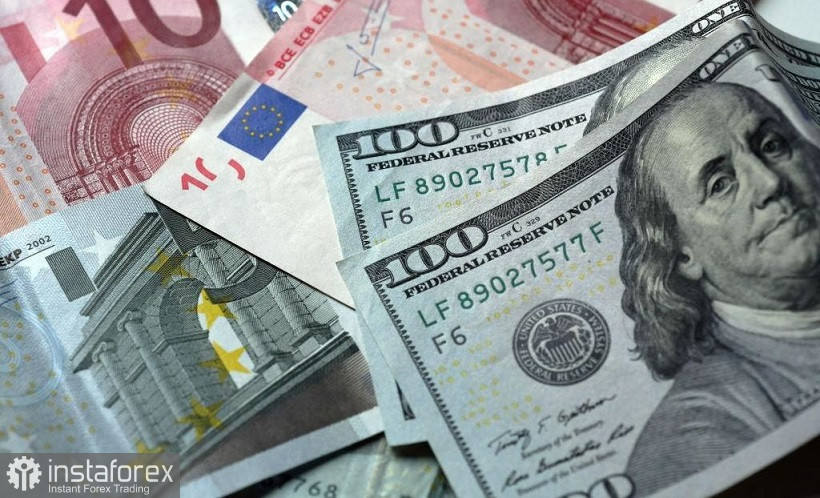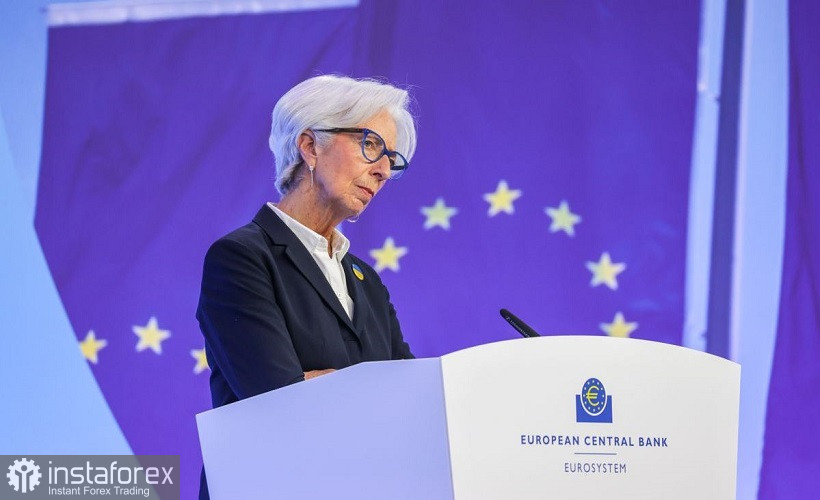The euro-dollar pair is stuck in the quagmire of a 100-point flat. The next week passed under the sign of an almost equal confrontation: bulls of EUR/USD tried to get close to the 6th figure, while bears once again tried to develop a downward trend, for which it is necessary to firmly settle below the 1.0500 mark. However, the results of the past week indicate that both sides lost. The high of the week was at 1.0606, the low at 1.0470. By and large, last week traders repeated the trajectory of the week before last. The four-hour, daily and weekly charts of EUR/USD show us long spires on candles, which indicate the indecisiveness of both the bulls of the pair and the bears. As soon as the price approaches the boundaries of the 1.0480-1.0580 range, traders take profits, thereby extinguishing the upward or downward momentum. Market participants do not risk going beyond the already established price range, while the fundamental picture of the week did not provide them with an advising information reason.

The central event of the past week was the speech of Federal Reserve Chairman Jerome Powell in Congress. He announced the semi-annual report to the congressmen, and then commented on the current situation, assessing the prospects for the Fed's monetary policy. Ahead of this event, many experts assumed that Powell would take an extremely hawkish position, in line with the recently announced results of the Fed's June meeting. Let me remind you that at the final press conference, the head of the US central bank commented on the unexpected increase in the interest rate by 75 basis points. He admitted that the central bank intended to keep the 50-point rate hike, "as it expected inflation to smooth out in the second quarter." However, after the release of the latest inflation report, the members of the central bank decided to raise the rate by 75 points at once.
Given Powell's rhetoric following the June meeting, many experts assumed that he would also voice hawkish messages in Congress, advocating for a 75-point rate hike in July and September. But here Powell disappointed dollar bulls: his speech to congressmen was too diplomatic and cautious. He did not trap himself into his own public commitments. In his characteristic manner, Powell assured those present that the Fed will continue to tighten monetary policy, but the rate of increase will depend on the dynamics of inflation indicators.
Such diplomacy was not to the liking of dollar bulls: the greenback sank throughout the market, including in pairs with the euro. The EUR/USD pair updated the high of the week, reaching the 1.06 mark. But literally the next day, the bears seized the initiative again, returning the pair to the base of the 5th figure. Market participants have come to a reasonable conclusion that the Fed will in any case tighten monetary policy more aggressively against the central banks of the leading countries of the world, including the ECB.
And here it is necessary to recall the recent speech of ECB President Christine Lagarde, who spoke with the deputies of the European Parliament on Tuesday. On the one hand, she confirmed that the ECB plans to raise the rate by 0.25% following the results of the July meeting. But on the other hand, the head of the central bank made it clear that the September increase is still an unresolved issue. According to her, the ECB may raise its interest rates again in September "if the situation requires it."

This position runs counter to the predictions of many currency strategists. For example, according to Deutsche Bank analysts, the ECB will raise the rate by 25 basis points in July, and by 50 basis points in September. As a result, the deposit rate should rise to 0.25% in early autumn. But, as we see, even this "conditionally hawkish" scenario is under a big question. Moreover, disappointing data on PMI indices in the eurozone and Germany were published this week, as well as a disappointing IFO business climate index in Germany. These releases revived fears of a recession in Europe.
All this suggests that the ECB, on the one hand, must regain control over prices, repaying the abrupt inflationary growth. On the other hand, the ECB should not provoke a panic in the bond markets of the most vulnerable EU countries. That is, on one side of the scale - the fight against inflation, on the other - the risk of recession. Under such circumstances, one should not expect Lagarde to tighten her rhetoric: now we can only speak with confidence about raising the interest rate in July. Future prospects look vague. While the Fed is guaranteed to increase the interest rate at each meeting until the end of the year - at least 50-point steps.
Thus, the prevailing fundamental background indicates the priority of short positions in the EUR/USD pair. The first and so far the main target of the downward price movement is the level of 1.0480 – this is the Tenkan-sen line on the daily chart. If the bears manage to overcome this target, the next target will be the "round" and psychologically important level of 1.0400.
 English
English 
 Русский
Русский Bahasa Indonesia
Bahasa Indonesia Bahasa Malay
Bahasa Malay ไทย
ไทย Español
Español Deutsch
Deutsch Български
Български Français
Français Tiếng Việt
Tiếng Việt 中文
中文 বাংলা
বাংলা हिन्दी
हिन्दी Čeština
Čeština Українська
Українська Română
Română

